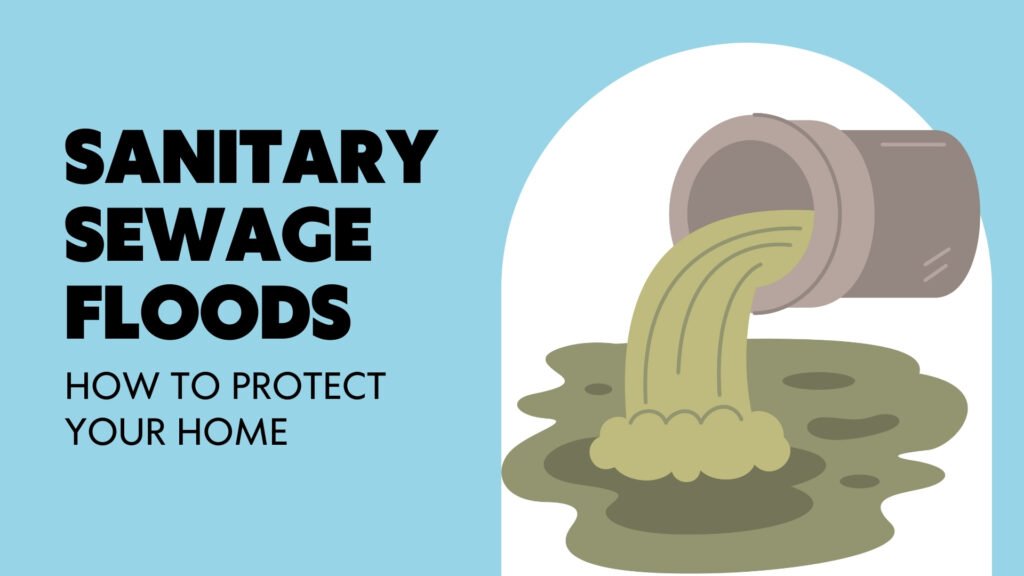SANITARY SEWAGE FLOODS – HOW TO PROTECT YOUR HOME

There are many places where water can come from to flood your home. As such, there are many different steps that a homeowner can take to protect their home from flooding. In this blog, we will explain where sanitary sewer flood water comes from and what steps you can take to protect your property.
The first distinction is between sewage floods, water line floods, and stormwater flooding. For our discussion regarding rainwater flooding, click here. For our discussion regarding water line floods, click here.
The drains of your home all flow down to a 4 inch main drain under your basement floor. This collects all the water when you flush the toilet, use the shower, run the dishwasher or wash your hands. From there, the main drain is sloped to transport the sewage out of your home, underneath your front yard and to the city sewer lines. In a properly functioning system all of this happens automatically.
There are 3 primary types of issues that can occur in a drainage system which cause flooding.
- Broken piping – This is when the piping system gets physically damaged. This can happen from a specific incident (i.e. something falls on the pipe) or it can gradually happen over time.
- Blockages – This is when the pipe fills up at a certain point and does not allow anything to flow. The blockage can be caused by roots, grease, hair, dirt, feminine products, “flushable” wipes or even a collapse of the pipe itself.
- City backups – This is when the city sewers are pushed past their capacity. This typically happens during storm conditions or when there is a blockage in the city sewer system. When this occurs, all excess sewage will back up into the nearest private homes that are not protected by a backwater valve.
There are many different materials that are used to construct drainage systems. Each type of material is prone to different types of failures. Generally, houses built before 1980 have clay drains; cast iron stacks; copper branch lines; and occasionally chrome fixtures. Houses built since 1980 will have their drainage done in various types of plastic. Below we will outline the ones most commonly found in the Greater Toronto Area.
- Copper piping is rarely found in the stack (the vertical portion of your drainage system) and more commonly in the branch lines and fixture drains. Over time, the walls of the pipe become thinner until eventually the pipe caves in on itself. The pipe is particularly vulnerable on bends. Repairs generally consist of cutting out sections of the pipe and replacing them with newer plastic piping. This can also be an opportune time to replace the entire copper portion of the plumbing system because once part of the system fails, the rest of the system is not far behind.
- Chrome piping is found almost exclusively on fixture drains. It is generally done for aesthetic purposes. They are very low quality and are prone to critical failure. What happens is that like copper drains, the chrome pipe slowly corrodes and eventually entire sections of piping fall away. A good way to check is if the drain under your sink is metal and it feels bumpy instead of smooth, critical failure is imminent.
- Cast iron piping is typically found in the stack. This was the material of choice for builders until plastic took over in the 1970s. The issue with cast iron is that it rusts from the inside. This slowly shrinks the internal diameter of the pipe and will eventually cause a blockage. In addition to blocking the pipe, the walls of the pipe become thinner and are thus more susceptible to leakage. Repair of cast iron piping is similar to repairing copper piping. The defective section is cut out and replaced with plastic. As with copper piping, this also presents an opportunity to replace the entire cast iron stack as minor failure today is generally an indicator of critical failure in the near future.
- Clay piping is found underground and was typically installed in the Greater Toronto Area until the 1970s. These systems have a typical lifespan of approximately 50 years. Clay pipes are installed in 4 foot sections. Each joint has the potential for failure as the ground settles underneath the house. Once a joint fails, it creates a small leak that becomes an active target for roots. The moisture and sewage attract roots. The roots in turn expand the opening in the pipe. This in turn attracts more roots and the snowball effect continues. The first issue you will notice is that your main drain will block up with roots. This will cause your basement plumbing to overflow. Given enough time, the pipe will collapse on itself and will require you to dig it up and replace it.
- Plastic piping has been the material of choice for the last 40-50 years or so. The advantages of plastic is that it is inexpensive to purchase, is relatively simple to install and is more durable than the alternative piping methods. The most common issues with plastic piping when installed underground are from installer error. Sometimes the pipes can be sloped backwards causing water to backup. Other times, after the ground settles, something called a banana can develop. A banana is when part of the pipe sags below the rest of the system causing improper drainage. There are several types of plastic piping, each with its own application
- PVC SDR35 is an extremely brittle, low quality pipe that is only approved for use underground. They make this in white and in green. The only difference between the white wall and the green wall is the application. White is for storm drain water whereas green is for sanitary sewer water.
- ABS is what most residential drains are made from today in the Greater Toronto Area. These are the black drain pipes that you typically see when you look under your sink. When doing repairs on other systems, the new section of pipe will be ABS. The one key drawback to ABS is that it is extremely flammable and releases toxic fumes when it burns. For this reason, it is only approved in single residential applications and is prohibited in condos and commercial spaces. There are also different qualities of ABS. There is cellcore ABS which has corrugated walls and there is the more durable solid core ABS which has solid walls. For the most part, contractors in Toronto install cellcore piping because it is cheaper and looks the same to the untrained eye.
- System 15 PVC and System XFR PVC are what is used in commercial and multi-residential (condo) applications. These plastic pipes are grey in color and are fire resistant. They also require special fire rated glue in order for the installation to be code compliant.
What is a backwater valve and how does it work?
We have discussed the various issues that can occur within your own plumbing system. The last issue we will cover is city backups. In this situation, the city system becomes overwhelmed and is unable to keep up with the drainage demands. This most commonly happens during heavy storms when the storm sewers overwhelm the entire city sewers. This causes water to back up into the nearest homes.
The good news about city backups is that they are very easy to protect yourself against. All it takes is a backwater valve to prevent the city from flooding your basement. A backwater valve is a one way door installed at the exit of your home. This valve only allows water to flow out of your home. As soon as water attempts to flow into your home, the valve closes and seals the pipe. Once the city flood conditions go away, the backwater valve will automatically reopen.
There are a few key things to remember if you have a backwater valve.
Your basement can still flood. It does not protect against all kinds of flooding, it only protects against city backups. If your drainage system leaks or there is a blockage in the system, a backwater valve will not protect you from that.
If the backwater valve is closed and protecting you from a city backup, it also prevents any water from leaving the home. What this means is that if you use your water during a city backup, there is nowhere for the water to drain. Therefore, all the water that you send down the drain will backup into your basement. For this reason, they also make backwater valves equipped with alarms so that you know when the valve is actively in operation. This lets you know not to use your plumbing system until the city backup has passed.
Many municipalities including the city of Toronto offer rebates for backwater valve installation or maintenance. In Toronto, there is a $1250 rebate that each home is eligible for (click here for more information). The rebate can only be used once at any given address. The easiest way to find out if your home is eligible for this rebate is to call 311 and ask them.

